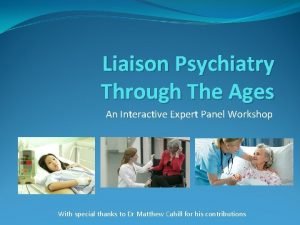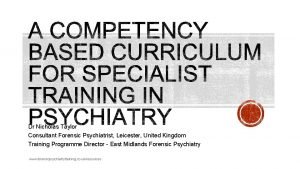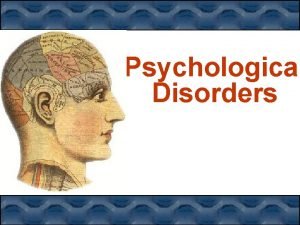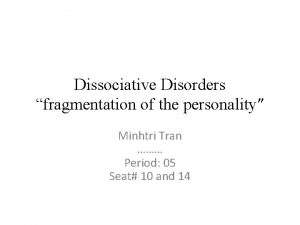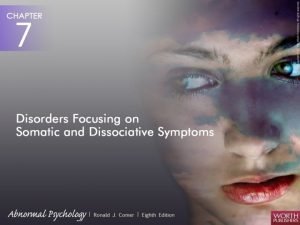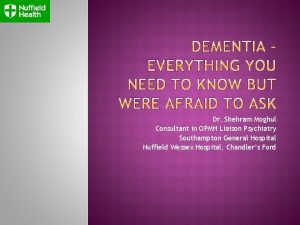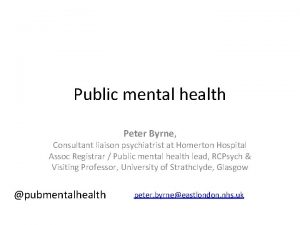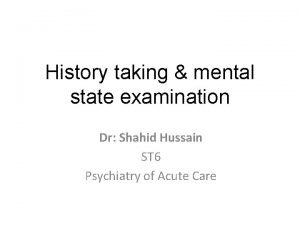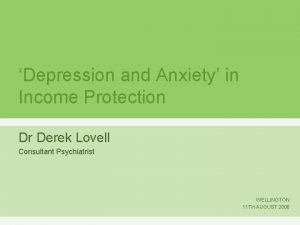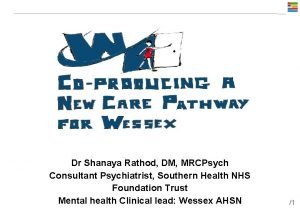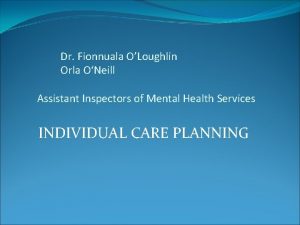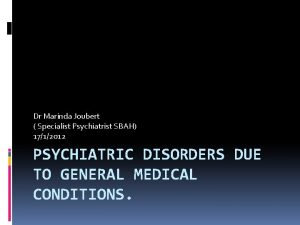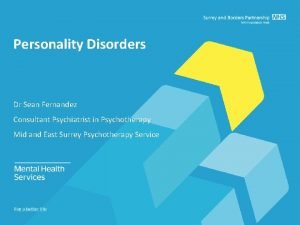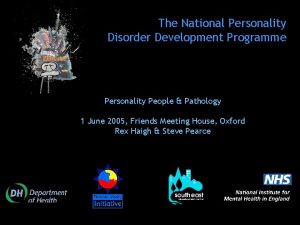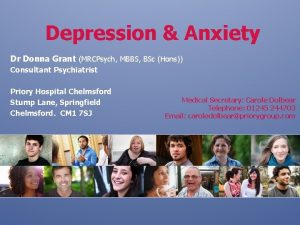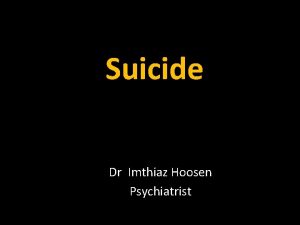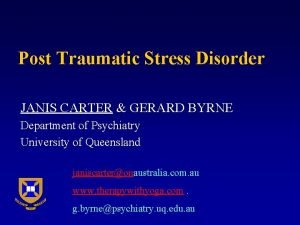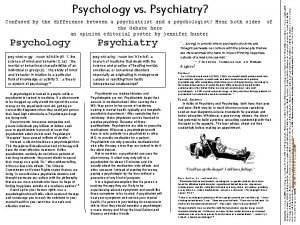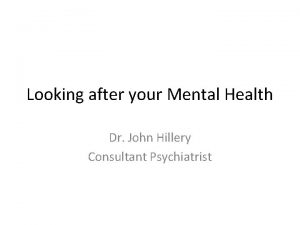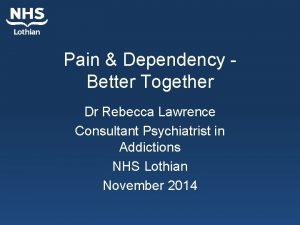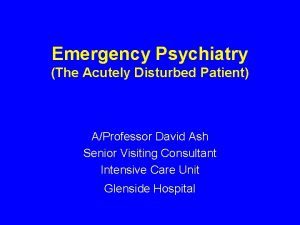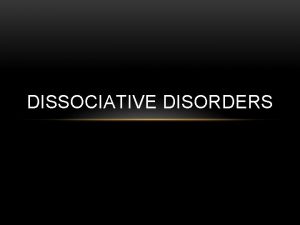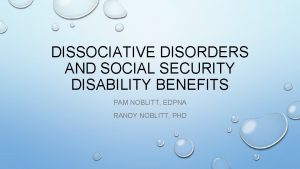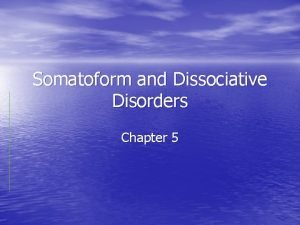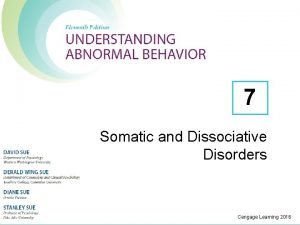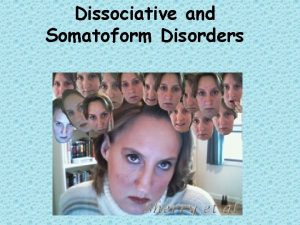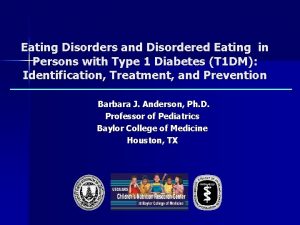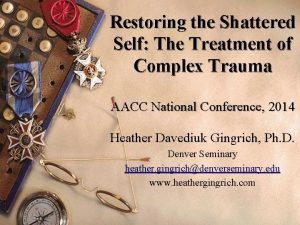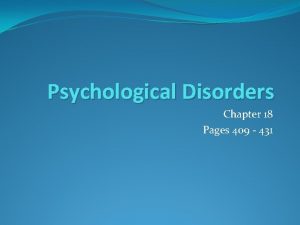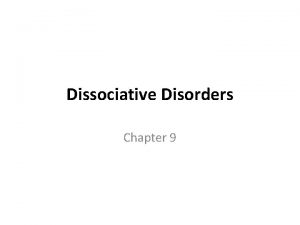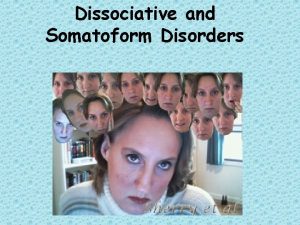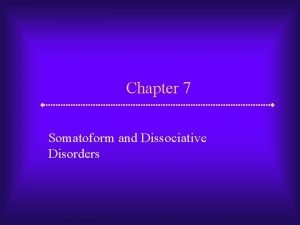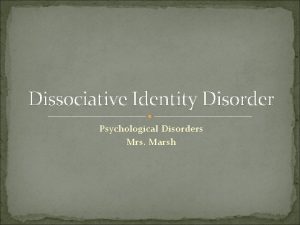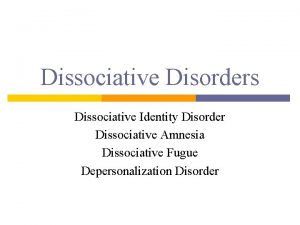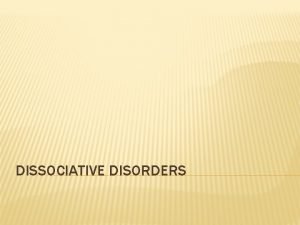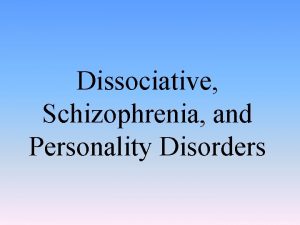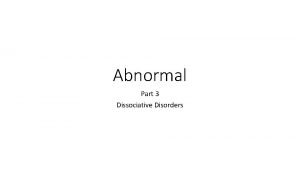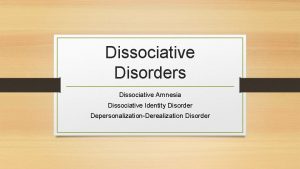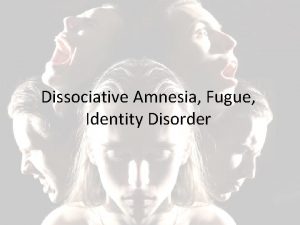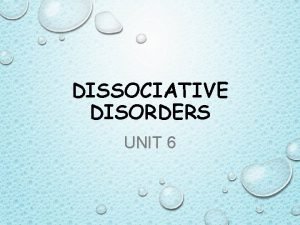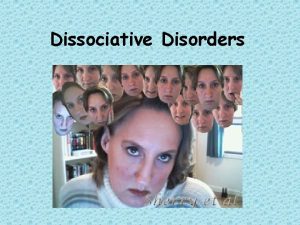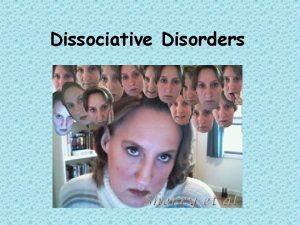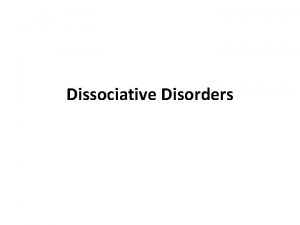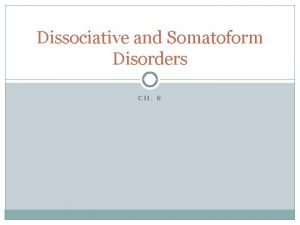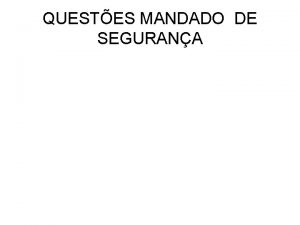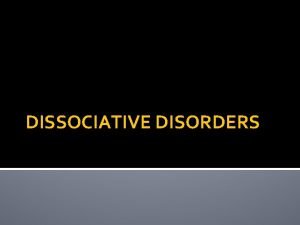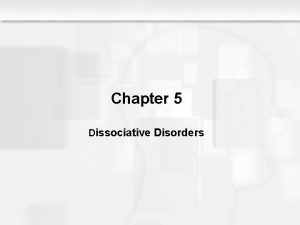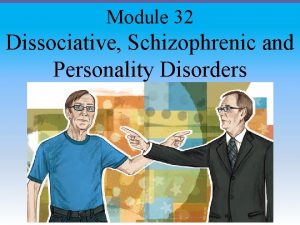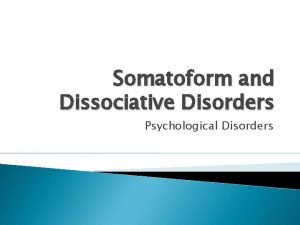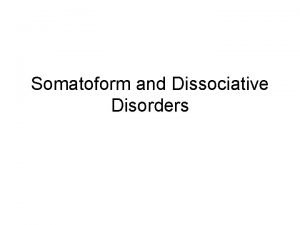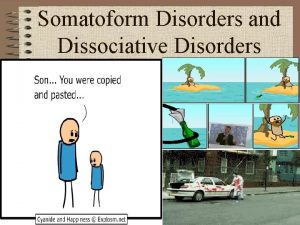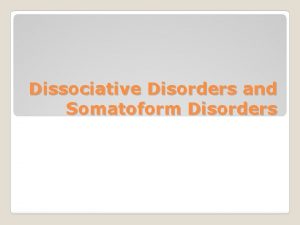DISSOCIATIVE DISORDERS Dr Pedro Hernandez Mandado Consultant Psychiatrist







































- Slides: 39

DISSOCIATIVE DISORDERS Dr. Pedro Hernandez Mandado Consultant Psychiatrist Consultant Professor Master in Sciences

DEFINITION � Dissociation is the fragmentation or separation of aspects of consciousness, including memory, identity and perception. Some degree of dissociation is always present; however, if an individual’s consciousness becomes too fragmented, it may pathologically interfere with the sense of self and ability to adapt. Presenting complaints and findings of dissociative disorders include amnesia, personality change, erratic behavior, odd inner experiences (e. g. / flashbacks, déjà vu), and confusion

�Dissociative disorders are also defined by a loss of memory (amnesia), identity, or sense of self (The normal integration of thoughts, behaviours, perceptions, feelings, and memory into a unique identity)

CAUSES � Most mental health professionals believe that the underlying cause of dissociative disorders is chronic trauma in childhood. Examples of trauma include repeated physical or sexual abuse, emotional abuse or neglect. � Unpredictable or frightening family environments may also cause the child to ‘disconnect’ from reality during times of stress.

� It seems that the severity of the dissociative disorder in adulthood is directly related to the severity of the childhood trauma. � Traumatic events that occur during adulthood may also cause dissociative disorders. Such events may include war, torture or going through a natural disaster.





TYPES OF DISSOCIATIVE DISORDERS �Dissociative amnesia �Dissociative fugue �Depersonalization disorder �Dissociative identity disorder (MPD) �Dissociative ddisorder not otherwise specified



DISSOCIATIVE AMNESIA � Dissociative amnesia is when a person can’t remember the details of a traumatic or successful event, although they do realise they are experiencing memory loss. This is also known as psychogenic amnesia. This type of amnesia can last from a few days to one or more years. Dissociative amnesia may be linked to other disorders such as an anxiety disorder.

� Risk factor is psychological stress � More common in women and young adults � Onset is usually detected retrospectively by discovery of memory gaps of extremely variable duration � The amnesia may suddenly or gradually remit, particularly when the traumatic circumstance resolves, or may become chronic. � It is associated with mood disorders, conversion disorder, and personality disorders � Differential diagnosis: amnestic disorder due to a general medical condition, substance-induced amnestic disorder, and other dissociative disorders.

The categories of dissociative amnesia include: Localised amnesia: for a time, the person has no memory of the traumatic event at all. For example, following an assault, a person with localised amnesia may not recall any details for a few days. � Selective amnesia: the person has patchy or incomplete memories of the traumatic event. � Generalised amnesia: the person has trouble remembering the details of their entire life. � Systematised amnesia: the person may have a very particular and specific memory loss; for example, they may have no recollection of one relative. � Continuous amnesia: occurs when patients have no memory of events up to and including the present time. This means that patients are alert and aware of their surroundings but are not able to remember anything. �

Dagnosis and DSM-IV Criteria �At least one episode of inability to recall important personal information, usually involving a traumatic or stressful event �The amnesia cannot be explained by ordinary forgefulness �Symptoms cause significant distress or impairment in daily functioning and cannot be explained by another disorder, including traumatic brain injury, medical condition, or substance use.


DISSOCIATIVE FUGUE � Dissociative fugue is also known as psychogenic fugue. The person suddenly, and without any warning, can’t remember who they are and has no memory of their past. They don’t realise they are experiencing memory loss and may invent a new identity. Typically, the person travels from home – sometimes over thousands of kilometers – while in the fugue, which may last between hours and months. When the person comes out of their dissociative fugue, they are usually confused with no recollection of the ‘new life’ they have made for themselves.

� Is Dissociative fugue characterized by sudden, unexpect travel away from home, accompanied by the inability to recall one’s identity or one’s past. � Patients may asume an enterily new identity and occupation after arriving in the new location. � They are unaware of their amnesia and new identity, and they never recall the period of the fugue. � Patients show characteristically low anxiety despite their confusión. Their affect is similar to “La belle indifference” of conversión responses

Diagnosis and DSM. IV Criteria �Sudden, unexpect travel away from home or work plus inability to recall one’s past. �Confusionabout personal identity or asumption of new identity �Not due to dissociative identity disorder or the physiological effects of a substance or medical disorder �Symptoms cause impairment in social or occupational functioning

Tratment for dissociative amnesia and dissociative fugue. Safety Psychotherapy Hypnosis Psychiatric drugs if neccesary


DEPERSONALISATION DISORDER �A dissociative disorder in which the sufferer is affected by persistent or recurrent feelings of depersonalisation and/or derealisation. � Brought by overwhelming feelings about a current event similar to a past traumatic event � The onset is rapid � The symptoms include a sense of automation, going through the motions of life but not experiencing it, feeling as thought one is in a dream, feeling a disconnection from one’s body, out-of-body experience, a detachment from one’s body, environment and difficulty relating oneself to reality.

� For all, it is a rather disturbing illness, since many feel that indeed, they are living in a dream. � They feel separated from themselves or outside their own bodies. � People with this disorder feel like they are going crazy and they frequently become anxious and depressed.

� Risk factor is psychological stress � Episodes of depersonalization are common � Usually in adolescence or early adulthood. Stressful events may precede the onset of the disorder. � Treatment is psychotherapy directed at decreasing anxiety � Major rule-outs are substance-induced mental disorders with dissociative symptoms, including intoxication, withdrawal, hallucinogen-induced persisting perceptual disorder, panic disorder, and PTSD.

Diagnosis and DSM-IV Criteria �Persistent or recurrent experiences of being detached from one’s body or mental processes. �Reality testing remains intact during episode �Causes social / occupational impairment, and cannot be accounted for by another mental or physical disorder.

Epidemiology. Twice as common in women More common among adolescents / Young adults Frequently comorbid with anxiety disorders and major depression. Severe stress is a predisposing factor Treatment. Antianxiety agents or SSRI to treat associated symptoms of anxiety or major depression.


DISSOCIATIVE IDENTITY DISORDER � Dissociative identity disorder is the most controversial of the dissociative disorders and is disputed and debated among mental health professionals. Previously called multiple personality disorder, this is the most severe kind of dissociative disorder. � It is characterised by switching to alterate identities when under stress. � Caused by severe childhood trauma and severe sexual abuse � More common in women

� the onset is insidious � A dissociative disorder involving a disturbance of identity in which two or more separate and distinct personality states (or identities) control the individual’s behavior at different times. When under the control of one identity, the person is usually unable to remember some of the events that occurred while other personalities were in control. � The different identities, referred to as alters, may exhibit differences in speech, mannerism, attitudes, thoughts, and gender orientation. � The alters may even differ in “physical” properties such as allergies, right-or-left handedness, or the need for eyeglass prescriptions. These differences between alters are often quite striking. � The person with DID may have as few as two alters, or as many as 100. the average number is about 10

� Comorbidity: borderline personality disorder, PTSD, major depression disorder and other mood disorders, substance-related disorders, sexual disorders, and eating disorders. � Symptoms may fluctuate or be continuous � Differential diagnosis: borderline personality disorder and other personality disorders, bipolar disorder with rapid cycling, factitious disorder, and malingering. � Psychotherapy to uncover psychologically traumatic memories and to resolve the associated emotional conflict

Diagnosis and DSM- Criteria � Presence of two or more distinct identities. � At least two of the identities recurrently take control of the person’s behaviour. � Inability to recall personal information of one personality when the other is dominant � Not due to effects of substance or medical condition.

Epidemiology. � 90 % of patients are women � Most patients have experience prior trauma, especially childhood physical or sexual abuse, � Average of onset is 6. The average of diagnosis is 30. � High incidence of comorbid with major depression, anxiety disorders, borderline personality disorder and substance abuse. � Up to one-third of patients attempt suicide.

COMPLICATIONS OF DD � Without treatment, possible complications for a person with a dissociative disorder may include: Ø Life difficulties such as broken relationships and job loss Ø Sleep problems such as insomnia Ø Sexual problems Ø Severe depression Ø Anxiety disorders Ø Eating disorders such as anorexia or bulimia Ø Problematic drug use including alcoholism Ø Self-harm, including suicide.

TREATMENT The effectiveness of treatments for dissociative disorders has not been studied. Treatment options are based on case studies, not research. Generally speaking, treatment may take many years. Options may include: � A safe environment: doctors will try to get the person to feel safe and relaxed, which is enough to trigger memory recall in some people with dissociative disorders. � Psychiatric drugs: such as barbiturates. � Hypnosis: may help to recover repressed memories, although this form of treatment for dissociative disorders is considered controversial.

� Psychotherapy: also known as ‘talk therapy’ or counselling, which is usually needed for the long term. Examples include cognitive therapy and psychoanalysis. � Stress management: since stress can trigger symptoms. � Treatment for other disorders: typically, a person with a dissociative disorder may have other mental health problems such as depression or anxiety. Treatment may include antidepressants or antianxiety medications to try to improve the symptoms of the dissociative disorder.

Dissociative disorder no otherwise specified. Primary dissociative disorder that share the characteristics of disruption in consciousness, memory, identity or perception but do not meet the criteria of the other specific categories are included in this category. Many of these disorders include cultual components and are very unlikely to be seen in the wards.

DIFFERENTIAL DIAGNOSIS � Ordinary forgetfulness and non pathological amnesia � Dementia, delirium, and organic amnestic disorders � Posttraumatic amnesia � Seizure disorders � Substance-related amnesia � Transient global amnesia � Acute stress disorder, posttraumatic stress disorder, and somatoform disorders � Malingering and factitious amnesia

THANKS
 Expert in consultant liaison psychiatrist
Expert in consultant liaison psychiatrist Psychiatrist leicester
Psychiatrist leicester Types of somatic disorder
Types of somatic disorder Types of dissociative disorders
Types of dissociative disorders Dissociative fuge
Dissociative fuge Dissociative disorders
Dissociative disorders Pedro hernandez guanir
Pedro hernandez guanir Dr moghul psychiatrist
Dr moghul psychiatrist Babor
Babor Dr shahid hussain psychiatrist
Dr shahid hussain psychiatrist Dr derek lovell psychiatrist
Dr derek lovell psychiatrist Dr shanaya rathod
Dr shanaya rathod Dr fionnuala o'loughlin psychiatrist
Dr fionnuala o'loughlin psychiatrist Dr marinda joubert
Dr marinda joubert Sean hood psychiatrist
Sean hood psychiatrist Dr steve pearce oxford
Dr steve pearce oxford Dr simon howard psychiatrist
Dr simon howard psychiatrist Donna grant psychiatrist
Donna grant psychiatrist Edward oxford
Edward oxford Dr hoosen psychiatrist
Dr hoosen psychiatrist Janis carter psychiatrist
Janis carter psychiatrist Psychiatrist vs psychologist
Psychiatrist vs psychologist John hillery psychiatrist
John hillery psychiatrist Dr rebecca lawrence psychiatrist
Dr rebecca lawrence psychiatrist David ash psychiatrist
David ash psychiatrist Dissociative fugue
Dissociative fugue Dissociative identity disorder social security disability
Dissociative identity disorder social security disability Dissociative identity disorder
Dissociative identity disorder Savant syndrome
Savant syndrome Dissociative
Dissociative Fugue dissociative
Fugue dissociative Associative and dissociative social process
Associative and dissociative social process Dissociative disorder not otherwise specified
Dissociative disorder not otherwise specified Restoring the shattered self
Restoring the shattered self Culture bound syndrome examples
Culture bound syndrome examples Nursing diagnosis of dissociative disorder
Nursing diagnosis of dissociative disorder Disociative fugue
Disociative fugue Dissociative state
Dissociative state Dissociative amnesia
Dissociative amnesia Dissociative disorder
Dissociative disorder
